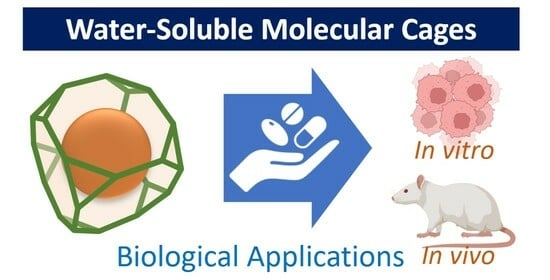Water-Soluble Molecular Cages for Biological Applications
Abstract
:1. Introduction
2. Scope of the Review
3. Main Concepts
Solubility and Stability in Water
4. Synthesis
4.1. Molecular Modelling
4.2. Strategies to Obtain Water-Soluble Molecular Cages
5. Biological Applications
5.1. Cancer Therapy
5.2. Other Biological Applications
6. Conclusions and Future Directions
Funding
Conflicts of Interest
References
- Lewis, J.E.M. Developing Sophisticated Microenvironments in Metal-organic Cages. Trends Chem. 2023, 5, 717–719. [Google Scholar] [CrossRef]
- Martí-Centelles, V.; Duarte, F.; Lusby, P.J. Host-Guest Chemistry of Self-Assembled Hemi-Cage Systems: The Dramatic Effect of Lost Pre-Organization. Isr. J. Chem. 2019, 59, 257–266. [Google Scholar] [CrossRef]
- Montà-González, G.; Sancenón, F.; Martínez-Máñez, R.; Martí-Centelles, V. Purely Covalent Molecular Cages and Containers for Guest Encapsulation. Chem. Rev. 2022, 122, 13636–13708. [Google Scholar] [CrossRef] [PubMed]
- Percástegui, E.G.; Ronson, T.K.; Nitschke, J.R. Design and Applications of Water-soluble Coordination Cages. Chem. Rev. 2020, 120, 13480–13544. [Google Scholar] [CrossRef]
- Takezawa, H.; Fujita, M. Molecular Confinement Effects by Self-assembled Coordination Cages. Bull. Chem. Soc. Jpn. 2021, 94, 2351–2369. [Google Scholar] [CrossRef]
- Martí-Centelles, V.; Lawrence, A.L.; Lusby, P.J. High Activity and Efficient Turnover by a Simple, Self-Assembled Artificial “Diels-Alderase”. J. Am. Chem. Soc. 2018, 140, 2862–2868. [Google Scholar] [CrossRef] [PubMed]
- Yu, Y.; Yang, J.M.; Rebek, J. Molecules in Confined Spaces: Reactivities and Possibilities in Cavitands. Chem 2020, 6, 1265–1274. [Google Scholar] [CrossRef]
- Pappalardo, A.; Puglisi, R.; Sfrazzetto, G.T. Catalysis inside Supramolecular Capsules: Recent Developments. Catalysts 2019, 9, 630. [Google Scholar] [CrossRef]
- Chen, S.; Chen, L.-J. Metal–organic Cages: Applications in Organic Reactions. Chemistry 2022, 4, 494–519. [Google Scholar] [CrossRef]
- Mal, P.; Breiner, B.; Rissanen, K.; Nitschke, J.R. White Phosphorus is Air-Stable within a Self-Assembled Tetrahedral Capsule. Science 2009, 324, 1697–1699. [Google Scholar] [CrossRef]
- Galan, A.; Ballester, P. Stabilization of Reactive Species by Supramolecular Encapsulation. Chem. Soc. Rev. 2016, 45, 1720–1737. [Google Scholar] [CrossRef] [PubMed]
- Zhang, D.; Ronson, T.K.; Zou, Y.-Q.; Nitschke, J.R. Metal–organic Cages for Molecular Separations. Nat. Rev. Chem. 2021, 5, 168–182. [Google Scholar] [CrossRef] [PubMed]
- Little, M.A.; Cooper, A.I. The Chemistry of Porous Organic Molecular Materials. Adv. Funct. Mater. 2020, 30, 1909842. [Google Scholar] [CrossRef]
- Zhang, J.; Xie, S.; Zi, M.; Yuan, L. Recent Advances of Application of Porous Molecular Cages for Enantioselective Recognition and Separation. J. Sep. Sci. 2020, 43, 134–149. [Google Scholar] [CrossRef] [PubMed]
- Zhang, G.; Mastalerz, M. Organic Cage Compounds-from Shape-Persistency to Function. Chem. Soc. Rev. 2014, 43, 1934–1947. [Google Scholar] [CrossRef] [PubMed]
- Liu, W.; Stoddart, J.F. Emergent Behavior in Nanoconfined Molecular Containers. Chem 2021, 7, 919–947. [Google Scholar] [CrossRef]
- Singh, M.; Sharma, R.; Banerjee, U.C. Biotechnological applications of cyclodextrins. Biotechnol. Adv. 2002, 20, 341–359. [Google Scholar] [CrossRef] [PubMed]
- Challa, R.; Ahuja, A.; Ali, J.; Khar, R.K. Cyclodextrins in Drug Delivery: An Updated Review. AAPS PharmSciTech 2005, 6, E329–E357. [Google Scholar] [CrossRef] [PubMed]
- Das, D.; Assaf, K.I.; Nau, W.M. Applications of Cucurbiturils in Medicinal Chemistry and Chemical Biology. Front. Chem. 2019, 7, 619. [Google Scholar] [CrossRef]
- Martí-Centelles, V.; Pandey, M.D.; Burguete, M.I.; Luis, S.V. Macrocyclization Reactions: The Importance of Conformational, Configurational, and Template-Induced Preorganization. Chem. Rev. 2015, 115, 8736–8834. [Google Scholar] [CrossRef]
- Martí-Centelles, V. Kinetic and thermodynamic concepts as synthetic tools in supramolecular chemistry for preparing macrocycles and molecular cages. Tetrahedron Lett. 2022, 93, 153676. [Google Scholar] [CrossRef]
- Lewis, J.E.M. Molecular Engineering of Confined Space in Metal–organic Cages. Chem. Commun. 2022, 58, 13873–13886. [Google Scholar] [CrossRef] [PubMed]
- Tateishi, T.; Yoshimura, M.; Tokuda, S.; Matsuda, F.; Fujita, D.; Furukawa, S. Coordination/metal–organic cages inside out. Coord. Chem. Rev. 2022, 467, 214612. [Google Scholar] [CrossRef]
- Yang, X.; Ullah, Z.; Stoddart, J.F.; Yavuz, C.T. Porous Organic Cages. Chem. Rev. 2023, 123, 4602–4634. [Google Scholar] [CrossRef] [PubMed]
- Rowan, S.J.; Cantrill, S.J.; Cousins, G.R.L.; Sanders, J.K.M.; Stoddart, J.F. Dynamic Covalent Chemistry. Angew. Chem. Int. Ed. 2002, 41, 898–952. [Google Scholar] [CrossRef]
- Makeiff, D.A.; Sherman, J.C. A Six-Bowl Carceplex That Entraps Seven Guest Molecules. J. Am. Chem. Soc. 2005, 127, 12363–12367. [Google Scholar] [CrossRef] [PubMed]
- Hiraoka, S. Unresolved Issues that Remain in Molecular Self-Assembly. Bull. Chem. Soc. Jpn. 2018, 91, 957–978. [Google Scholar] [CrossRef]
- Kai, S.; Martí-Centelles, V.; Sakuma, Y.; Mashiko, T.; Kojima, T.; Nagashima, U.; Tachikawa, M.; Lusby, P.J.; Hiraoka, S. Quantitative Analysis of Self-assembly Process of a Pd2L4 Cage Consisting of Rigid Ditopic Ligands. Chem. Eur. J. 2018, 24, 663–671. [Google Scholar] [CrossRef] [PubMed]
- Tateishi, T.; Takahashi, S.; Okazawa, A.; Martí-Centelles, V.; Wang, J.; Kojima, T.; Lusby, P.J.; Sato, H.; Hiraoka, S. Navigated Self-Assembly of a Pd2L4 Cage by Modulation of an Energy Landscape under Kinetic Control. J. Am. Chem. Soc. 2019, 141, 19669–19676. [Google Scholar] [CrossRef]
- Tateishi, T.; Kojima, T.; Hiraoka, S. Multiple Pathways in the Self-Assembly Process of a Pd4L8 Coordination Tetrahedron. Inorg. Chem. 2018, 57, 2686–2694. [Google Scholar] [CrossRef]
- Santolini, V.; Miklitz, M.; Berardo, E.; Jelfs, K.E. Topological Landscapes of Porous Organic Cages. Nanoscale 2017, 9, 5280–5298. [Google Scholar] [CrossRef] [PubMed]
- Piskorz, T.K.; Martí-Centelles, V.; Young, T.A.; Lusby, P.J.; Duarte, F. Computational Modeling of Supramolecular Metallo-organic Cages—Challenges and Opportunities. ACS Catal. 2022, 12, 5806–5826. [Google Scholar] [CrossRef] [PubMed]
- Tarzia, A.; Jelfs, K.E. Unlocking the Computational Design of Metal–organic Cages. Chem. Comm. 2022, 58, 3717–3730. [Google Scholar] [CrossRef] [PubMed]
- Greenaway, R.L.; Jelfs, K.E. High-throughput Approaches for the Discovery of Supramolecular Organic Cages. ChemPlusChem 2020, 85, 1813–1823. [Google Scholar] [CrossRef] [PubMed]
- Martí-Centelles, V.; Piskorz, T.K.; Duarte, F. Cagecavitycalc (C3): A Computational Tool for Calculating and Visualizing Cavities in Molecular Cages. ChemRxiv 2024. [Google Scholar] [CrossRef]
- Chakraborty, D.; Mukherjee, P.S. Recent Trends in Organic Cage Synthesis: Push towards Water-soluble Organic Cages. Chem. Commun. 2022, 58, 5558–5573. [Google Scholar] [CrossRef] [PubMed]
- Yoon, J.; Cram, D.J. The First Water-Soluble Hermicarceplexes. Chem. Commun. 1997, 118, 497–498. [Google Scholar] [CrossRef]
- Barwell, N.P.; Davis, A.P. Substituent Effects in Synthetic Lectins—Exploring the Role of CH-π Interactions in Carbohydrate Recognition. J. Org. Chem. 2011, 76, 6548–6557. [Google Scholar] [CrossRef] [PubMed]
- Howgego, J.D.; Butts, C.P.; Crump, M.P.; Davis, A.P. An Accessible Bicyclic Architecture for Synthetic Lectins. Chem. Commun. 2013, 49, 3110–3112. [Google Scholar] [CrossRef]
- Joshi, G.; Davis, A.P. New H-Bonding Patterns in Biphenyl-Based Synthetic Lectins; Pyrrolediamine Bridges Enhance Glucose Selectivity. Org. Biomol. Chem. 2012, 10, 5760–5763. [Google Scholar] [CrossRef]
- Liu, X.; Sun, J.; Warmuth, R. Water-Soluble Octahedral Polyammonium Nanocapsules: Synthesis and Encapsulation Studies. Tetrahedron 2009, 65, 7303–7310. [Google Scholar] [CrossRef]
- Gavette, J.V.; Zhang, K.D.; Ajami, D.; Rebek, J. Folded Alkyl Chains in Water-Soluble Capsules and Cavitands. Org. Biomol. Chem. 2014, 12, 6561–6563. [Google Scholar] [CrossRef] [PubMed]
- Gavette, J.V.; Petsalakis, I.D.; Theodorakopoulos, G.; Zhang, K.D.; Yu, Y.; Rebek, J. The Effects of Hexafluoroisopropanol on Guest Binding by Water-Soluble Capsule and Cavitand Hosts. Chem. Commun. 2015, 51, 17604–17606. [Google Scholar] [CrossRef] [PubMed]
- Lin, Z.; Sun, J.; Efremovska, B.; Warmuth, R. Assembly of Water-Soluble, Dynamic, Covalent Container Molecules and Their Application in the Room-Temperature Stabilization of Protoadamantene. Chem. Eur. J. 2012, 18, 12864–12872. [Google Scholar] [CrossRef] [PubMed]
- Eichstaedt, K.; Szpotkowski, K.; Grajda, M.; Gilski, M.; Wosicki, S.; Jaskólski, M.; Szumna, A. Self-assembly and Ordering of Peptide-based Cavitands in Water and DMSO: The Power of Hydrophobic Effects Combined with Neutral Hydrogen Bonds. Chem. Eur. J. 2019, 25, 3091–3097. [Google Scholar] [CrossRef] [PubMed]
- Fankhauser, D.; Kolarski, D.; Grüning, W.R.; Diederich, F. Resorcin[4]Arene-Based Molecular Baskets and Water-Soluble Container Molecules: Synthesis and 1H NMR Host-Guest Complexation Studies. Eur. J. Org. Chem. 2014, 2014, 3575–3583. [Google Scholar] [CrossRef]
- Tyagi, R.; Witte, C.; Haag, R.; Schröder, L. Dendronized Cryptophanes as Water-Soluble Xenon Hosts for 129Xe Magnetic Resonance Imaging. Org. Lett. 2014, 16, 4436–4439. [Google Scholar] [CrossRef] [PubMed]
- Hafezi, N.; Holcroft, J.M.; Hartlieb, K.J.; Dale, E.J.; Vermeulen, N.A.; Stern, C.L.; Sarjeant, A.A.; Stoddart, J.F. Modulating the Binding of Polycyclic Aromatic Hydrocarbons Inside a Hexacationic Cage by Anion-π Interactions. Angew. Chem. Int. Ed. 2015, 54, 456–461. [Google Scholar] [CrossRef] [PubMed]
- Jiao, T.; Cai, K.; Liu, Z.; Wu, G.; Shen, L.; Cheng, C.; Feng, Y.; Stern, C.L.; Stoddart, J.F.; Li, H. Guest Recognition Enhanced by Lateral Interactions. Chem. Sci. 2019, 10, 5114–5123. [Google Scholar] [CrossRef]
- Chakraborty, D.; Modak, R.; Howlader, P.; Mukherjee, P.S. De Novo Approach for Synthesis of Water-Soluble Interlocked and Non-Interloked Organic Cages. Chem. Commun. 2021, 57, 3995–3998. [Google Scholar] [CrossRef]
- Chen, Y.; Wu, G.; Chen, L.; Tong, L.; Lei, Y.; Shen, L.; Jiao, T.; Li, H. Selective Recognition of Chloride Anion in Water. Org. Lett. 2020, 22, 4878–4882. [Google Scholar] [CrossRef] [PubMed]
- Wang, H.; Fang, S.; Wu, G.; Lei, Y.; Chen, Q.; Wang, H.; Wu, Y.; Lin, C.; Hong, X.; Kim, S.K.; et al. Constraining Homo- and Heteroanion Dimers in Ultraclose Proximity within a Self-Assembled Hexacationic Cage. J. Am. Chem. Soc. 2020, 142, 20182–20190. [Google Scholar] [CrossRef] [PubMed]
- Zheng, X.; Zhang, Y.; Wu, G.; Liu, J.R.; Cao, N.; Wang, L.; Wang, Y.; Li, X.; Hong, X.; Yang, C.; et al. Temperature-Dependent Self-Assembly of a Purely Organic Cage in Water. Chem. Commun. 2018, 54, 3138–3141. [Google Scholar] [CrossRef] [PubMed]
- Fujita, M.; Oguro, D.; Miyazawa, M.; Oka, H.; Yamaguchi, K.; Ogura, K. Self-Assembly of Ten Molecules into Nanometer-Sized Host Frameworks. Nature 1995, 378, 469–471. [Google Scholar] [CrossRef]
- Ibukuro, F.; Kusukawa, T.; Fujita, M. A Thermally Switchable Molecular Lock. Guest-Templated Synthesis of a Kinetically Stable Nanosized Cage. J. Am. Chem. Soc. 1998, 120, 8561–8562. [Google Scholar] [CrossRef]
- Hastings, C.J.; Pluth, M.D.; Bergman, R.G.; Raymond, K.N. Enzymelike Catalysis of the Nazarov Cyclization by Supramolecular Encapsulation. J. Am. Chem. Soc. 2010, 132, 6938–6940. [Google Scholar] [CrossRef] [PubMed]
- Mal, P.; Schultz, D.; Beyeh, K.; Rissanen, K.; Nitschke, J.R. An Unlockable-Relockable Iron Cage by Subcomponent Self-Assembly. Angew. Chem. Int. Ed. 2008, 47, 8297–8301. [Google Scholar] [CrossRef] [PubMed]
- Clegg, J.K.; Cremers, J.; Hogben, A.J.; Breiner, B.; Smulders, M.M.J.; Thoburn, J.D.; Nitschke, J.R. A Stimuli Responsive System of Self-Assembled Anion-Binding Fe4L68+ Cages. Chem. Sci. 2013, 4, 68–76. [Google Scholar] [CrossRef]
- Bolliger, J.L.; Belenguer, A.M.; Nitschke, J.R. Enantiopure Water-Soluble [Fe4L6] Cages: Host-Guest Chemistry and Catalytic Activity. Angew. Chem. Int. Ed. 2013, 52, 7958–7962. [Google Scholar] [CrossRef]
- Whitehead, M.; Turega, S.; Stephenson, A.; Hunter, C.A.; Ward, M.D. Quantification of Solvent Effects on Molecular Recognition in Polyhedral Coordination Cage Hosts. Chem. Sci. 2013, 4, 2744–2751. [Google Scholar] [CrossRef]
- Casini, A.; Woods, B.; Wenzel, M. The Promise of Self-Assembled 3D Supramolecular Coordination Complexes for Biomedical Applications. Inorg. Chem. 2017, 56, 14715–14729. [Google Scholar] [CrossRef] [PubMed]
- Zhu, C.-Y.; Pan, M.; Su, C.-Y. Metal-Organic Cages for Biomedical Applications. Isr. J. Chem. 2018, 59, 209–219. [Google Scholar] [CrossRef]
- Dou, W.-T.; Yang, C.-Y.; Hu, L.-R.; Song, B.; Jin, T.; Jia, P.-P.; Ji, X.; Zheng, F.; Yang, H.-B.; Xu, L. Metallacages and Covalent Cages for Biological Imaging and Therapeutics. ACS Mater. Lett. 2023, 5, 1061–1082. [Google Scholar] [CrossRef]
- Ahmad, N.; Younus, H.A.; Chughtai, A.H.; Verpoort, F. Metal–organic Molecular Cages: Applications of Biochemical Implications. Chem. Soc. Rev. 2015, 44, 9–25. [Google Scholar] [CrossRef] [PubMed]
- Sun, D.; Feng, X.; Zhu, X.; Wang, Y.; Yang, J. Anticancer Agents Based on Metal Organic Cages. Coord. Chem. Rev. 2024, 500, 215546. [Google Scholar] [CrossRef]
- Cruz-Nava, S.; De Jesús Valencia-Loza, S.; Percástegui, E.G. Protection and Transformation of Natural Products within Aqueous Metal-organic Cages. Eur. J. Org. Chem. 2022, 2022, e202200844. [Google Scholar] [CrossRef]
- Tapia, L.; Alfonso, I.; Solà, J. Molecular Cages for Biological Applications. Org. Biomol. Chem. 2021, 19, 9527–9540. [Google Scholar] [CrossRef]
- Zheng, Y.-R.; Suntharalingam, K.; Johnstone, T.C.; Lippard, S.J. Encapsulation of Pt(iv) Prodrugs Within a Pt(ii) Cage for Drug Delivery. Chem. Sci. 2015, 6, 1189–1193. [Google Scholar] [CrossRef]
- Yue, Z.; Wang, H.; Bowers, D.J.; Gao, M.; Stilgenbauer, M.; Nielsen, F.; Shelley, J.T.; Zheng, Y.-R. Nanoparticles of Metal–organic Cages Designed to Encapsulate Platinum-based Anticancer Agents. Dalton Trans. 2018, 47, 670–674. [Google Scholar] [CrossRef]
- Bhat, I.A.; Jain, R.; Siddiqui, M.M.; Saini, D.K.; Mukherjee, P.S. Water-Soluble Pd8L4 Self-assembled Molecular Barrel as an Aqueous Carrier for Hydrophobic Curcumin. Inorg. Chem. 2017, 56, 5352–5360. [Google Scholar] [CrossRef]
- Liang, Y.; Fang, Y.; Cui, Y.; Zhou, H. A Stable Biocompatible Porous Coordination Cage Promotes In Vivo Liver Tumor Inhibition. Nano Res. 2021, 14, 3407–3415. [Google Scholar] [CrossRef]
- Fang, Y.; Lian, X.; Huang, Y.; Fu, G.; Xiao, Z.; Wang, Q.; Nan, B.; Pellois, J.; Zhou, H. Investigating Subcellular Compartment Targeting Effect of Porous Coordination Cages for Enhancing Cancer Nanotherapy. Small 2018, 14, 1802709. [Google Scholar] [CrossRef] [PubMed]
- Gunawardana, V.W.L.; Ward, C.; Wang, H.; Holbrook, J.H.; Sekera, E.R.; Cui, H.; Hummon, A.B.; Badjić, J.D. Crystalline Nanoparticles of Water-soluble Covalent Basket Cages (cbcs) for Encapsulation of Anticancer Drugs. Angew. Chem. Int. Ed. 2023, 62, e202306722. [Google Scholar] [CrossRef] [PubMed]
- Wang, H.; Qiu, Z.; Liu, H.; Jayawardhana, A.M.D.S.; Yue, Z.; Daghlas, H.; Bowers, D.J.; Datta, B.; Zheng, Y.-R. Nanoparticles of Metal-organic Cages Overcoming Drug Resistance in Ovarian Cancer. Front. Chem. 2019, 7, 39. [Google Scholar] [CrossRef] [PubMed]
- Ahmedova, A.; Mihaylova, R.; Momekova, D.; Shestakova, P.; Stoykova, S.; Zaharieva, J.; Yamashina, M.; Momekov, G.; Akita, M.; Yoshizawa, M. M2L4 Coordination Capsules with Tunable Anticancer Activity upon Guest Encapsulation. Dalton Trans. 2016, 45, 13214–13221. [Google Scholar] [CrossRef] [PubMed]
- Ahmedova, A.; Momekova, D.; Yamashina, M.; Shestakova, P.; Momekov, G.; Akita, M.; Yoshizawa, M. Anticancer Potencies of Ptii- and Pdii-linked M2L4 Coordination Capsules with Improved Selectivity. Chem. Asian J. 2016, 11, 474–477. [Google Scholar] [CrossRef] [PubMed]
- Davis, A.P. Synthetic Lectins. Org. Biomol. Chem. 2009, 7, 3629–3638. [Google Scholar] [CrossRef] [PubMed]
- Barwell, N.P.; Crump, M.P.; Davis, A.P. A Synthetic Lectin for Β-glucosyl. Angew. Chem. Int. Ed. 2009, 48, 7673–7676. [Google Scholar] [CrossRef] [PubMed]
- Li, W.-Y.; Zhao, C.-W.; Zhang, Y.-F.; Guan, Q.; Wan, J.-J.; Ma, J.-P.; Li, Y.-A.; Dong, Y.-B. A metal–organic cage-based nanoagent for enhanced photodynamic antitumor therapy. Chem. Commun. 2021, 57, 7954–7957. [Google Scholar] [CrossRef]
- Burke, B.P.; Grantham, W.; Burke, M.J.; Nichol, G.S.; Roberts, D.; Renard, I.; Hargreaves, R.; Cawthorne, C.; Archibald, S.J.; Lusby, P.J. Visualizing Kinetically Robust CoIII4L6 Assemblies In Vivo: SPECT Imaging of the Encapsulated [99mTc]TcO4– Anion. J. Am. Chem. Soc. 2018, 140, 16877–16881. [Google Scholar] [CrossRef]



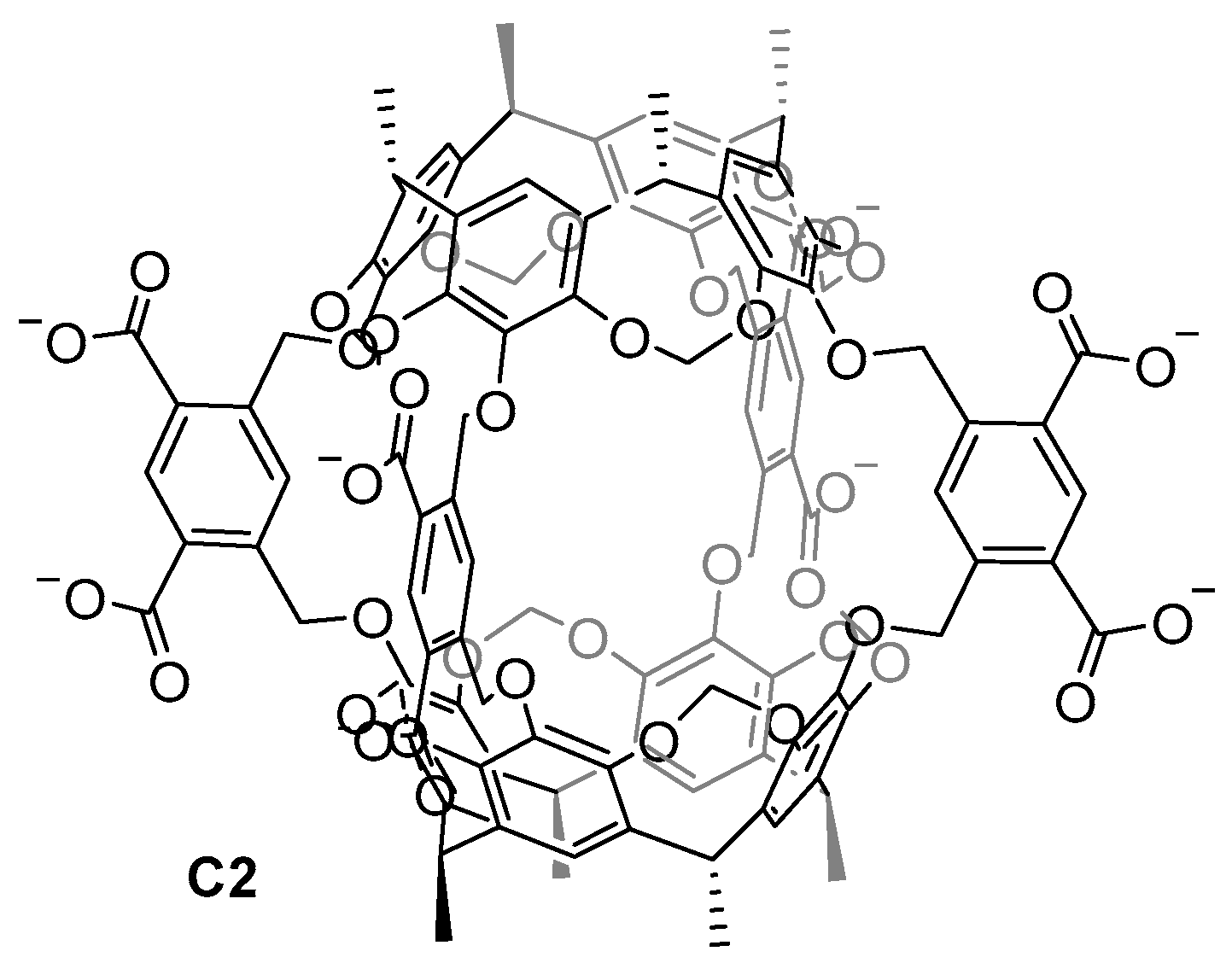




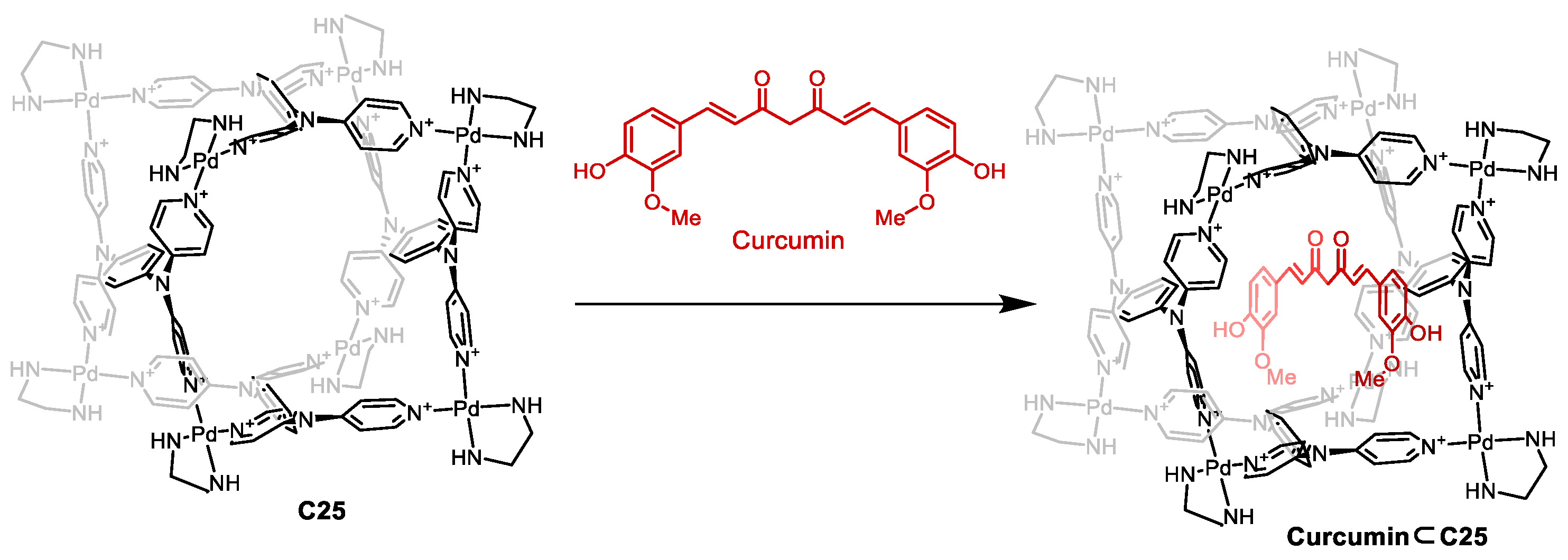
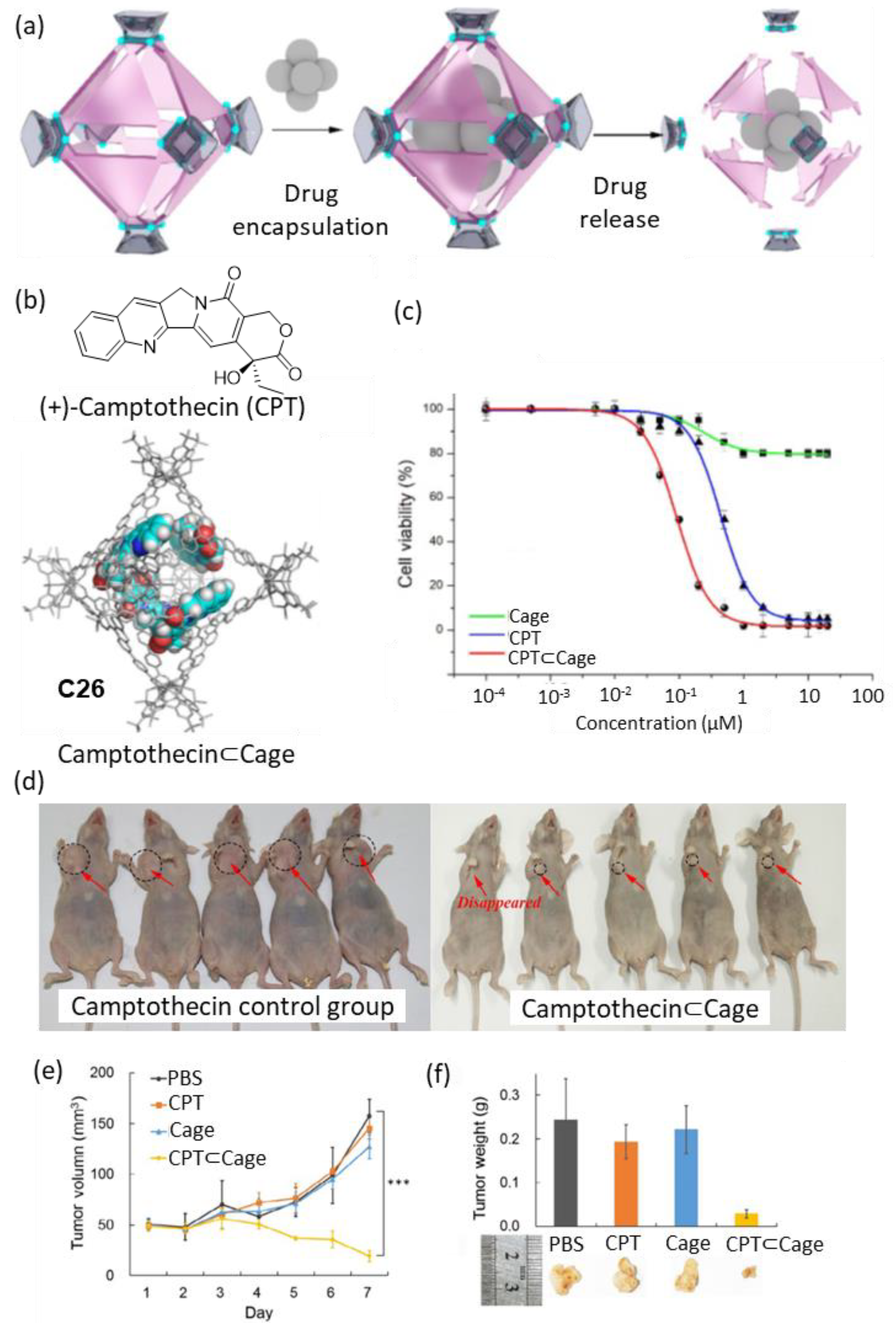

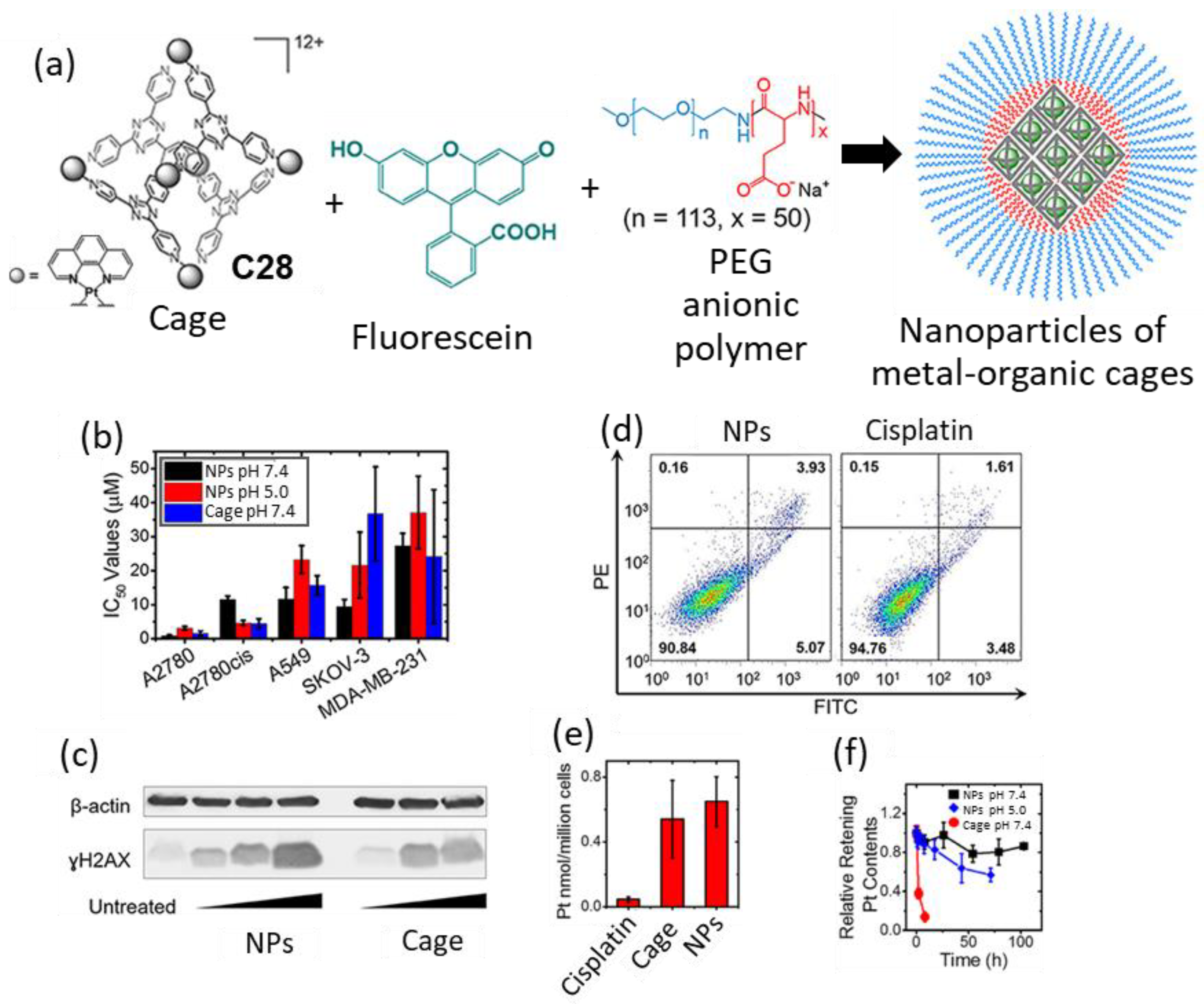




| Compound | HL-60 | HL-60/Dox | HT-29 | T-24 |
|---|---|---|---|---|
| (pyrene)2⊂C29-Pt | 22.8 | 21.5 | 109.4 | >100 |
| (caffeine)2⊂C29-Pt | 2.6 | 5.0 | 18.2 | >100 |
| C29-Pt | 5.0 | 1.0 | 0.9 | 5.3 |
| (pyrene)2⊂C29-Pd | 2.5 | 8.4 | 69.3 | >100 |
| (caffeine)2⊂C29-Pd | 0.7 | 4.7 | 23.2 | >100 |
| C29-Pd | 1.6 | 1.1 | 17.5 | 37.4 |
| Ligand, pyrene, caffeine | >100 | >100 | >100 | >100 |
| Cisplatin | 9.3 | 32.9 | 36.6 | 13.5 |
Disclaimer/Publisher’s Note: The statements, opinions and data contained in all publications are solely those of the individual author(s) and contributor(s) and not of MDPI and/or the editor(s). MDPI and/or the editor(s) disclaim responsibility for any injury to people or property resulting from any ideas, methods, instructions or products referred to in the content. |
© 2024 by the authors. Licensee MDPI, Basel, Switzerland. This article is an open access article distributed under the terms and conditions of the Creative Commons Attribution (CC BY) license (https://creativecommons.org/licenses/by/4.0/).
Share and Cite
Montà-González, G.; Ortiz-Gómez, E.; López-Lima, R.; Fiorini, G.; Martínez-Máñez, R.; Martí-Centelles, V. Water-Soluble Molecular Cages for Biological Applications. Molecules 2024, 29, 1621. https://doi.org/10.3390/molecules29071621
Montà-González G, Ortiz-Gómez E, López-Lima R, Fiorini G, Martínez-Máñez R, Martí-Centelles V. Water-Soluble Molecular Cages for Biological Applications. Molecules. 2024; 29(7):1621. https://doi.org/10.3390/molecules29071621
Chicago/Turabian StyleMontà-González, Giovanni, Eduardo Ortiz-Gómez, Rocío López-Lima, Guillermo Fiorini, Ramón Martínez-Máñez, and Vicente Martí-Centelles. 2024. "Water-Soluble Molecular Cages for Biological Applications" Molecules 29, no. 7: 1621. https://doi.org/10.3390/molecules29071621
APA StyleMontà-González, G., Ortiz-Gómez, E., López-Lima, R., Fiorini, G., Martínez-Máñez, R., & Martí-Centelles, V. (2024). Water-Soluble Molecular Cages for Biological Applications. Molecules, 29(7), 1621. https://doi.org/10.3390/molecules29071621





